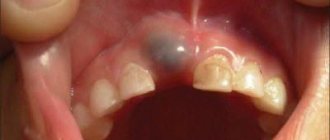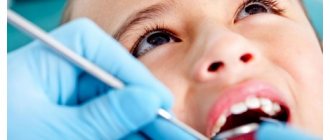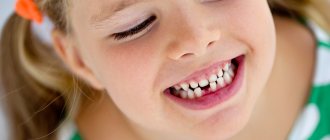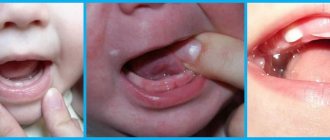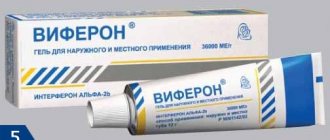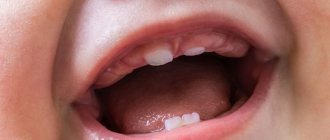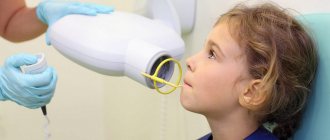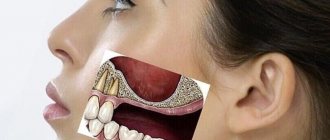Teething is a process characterized by the axial movement of teeth from a non-functional position (from the bone jaw tissue) to a functional position (on the surface of the alveolar process and gums). Most often, the formation of a temporary bite causes a lot of inconvenience, not only to the baby, but also to his worried parents. In this article from the “Pediatric Dentistry” section, we will try to figure out in what order baby teeth erupt, and what symptoms accompany the development of this process.
First signs
It is advisable to recognize the onset of teething in a child in time in order to be able to provide him with the necessary help. As a rule, symptoms of the upcoming appearance of the first tooth in a baby appear within a few days - in most children this period lasts up to several days and ends with the eruption of the outer shell of the gums.
Parents can recognize that their baby is starting to teethe by the following signs:
- The appearance of sudden changes in the child’s behavior: sleep disturbance, irritability, crying, refusal to take the breast or pacifier;
- The formation of increased salivation, often accompanied by the appearance of rashes around the baby’s mouth, chin, and chest due to excessive saliva;
- At the site of tooth eruption, the gums swell and become swollen;
- The child bites everything that gets into his hands, trying to relieve the irritating itching that appears in the gums.
How to recognize the symptoms of gingivitis in children?
The clinical picture is not always bright. In addition to certain discomfort and pain in the oral cavity, children experience bleeding gums, itching or burning in them, and bad breath. Babies may develop a fever, significantly increasing their suffering.
It will not be easy for even the most attentive mother to “diagnose” the disease based on such symptoms on her own. In addition, if a son or daughter has already had an unpleasant experience visiting a dental clinic, they can hide all the unpleasant signs, steadfastly enduring the discomfort.
It is advisable that by the age of 10–12 years, children already have their own dentist. Regular medical examinations with a doctor whom the child trusts will help, if not avoid problems, then at least diagnose them in a timely manner.
What you need to know about deadlines
With the correct development of the newborn’s body, teething occurs at certain times according to the principle of pairing. Usually identical teeth erupt at the same time - this applies to pairs of central and lateral incisors and canines.
At birth, there are 20 follicles in both jaws of the baby - 10 for each jaw, which are the rudiments of temporary teeth. The newborn also has 16 permanent tooth buds. Another 16 primordia begin to form after birth.
The order of eruption of baby teeth:
Important:
Here are the average dates for teething in newborns. However, the development of each organism is strictly individual, so it is possible that these dates may shift in one direction or another in approximately 50% of cases. Therefore, do not panic if deviations from the given deadlines are insignificant.
There are cases when a baby was born with the first tooth. This makes breastfeeding much more difficult, so you need to get appropriate advice from your doctor.
With artificial feeding, there may be a delay in teething, while a breastfed baby's teeth erupt earlier in 10 cases out of a hundred. In addition, the delay in the eruption of baby teeth is influenced by the condition of the mother during pregnancy - for example, toxicosis, infectious diseases, stress, as well as diseases suffered by the baby.
Structure
The structure of a baby tooth is significantly different from a molar tooth. Its enamel and dentin are thinner, their layers are 0.1-1 mm and 0.5-1.5 mm, respectively.
They are much smaller in size than molars, but the incisors are more convex in shape. Their root canals are wider, which increases the risk of bacteria entering and multiplying with subsequent inflammation.
The pulp of the front and chewing milk teeth in children occupies a larger volume than in the molar; on this topic, you can find many photos about the structure of a child’s jaw, what it consists of, and diagrams of the roots of the dentition in an adult and a child. In addition, children's teeth are characterized by a low degree of mineralization, and therefore are more vulnerable to caries. By the way, even adults sometimes have baby teeth, but usually no more than one.
What should you pay attention to when teething?
The above symptoms of the onset of teething are characteristic of almost all infants. However, some children have additional symptoms that need to be taken seriously:
- Temperature increase;
- Formation in the mouth of small watery blisters with cloudy or clear liquid;
- Increased redness and inflammation of the gums;
- Inflamed oral mucosa, accompanied by the formation of slight erosion.
In a healthy baby, when teething, contrary to popular belief and the advice of “experienced” relatives, the temperature does not rise. If this happens, it means that the child’s body is simultaneously exposed to some kind of inflammatory disease.
Most often, the listed signs indicate the development of a viral form of stomatitis or ARVI, which is not surprising given the child’s desire to put everything in his mouth. Therefore, you need to show the child to the doctor. If the pediatrician does not detect signs of an acute viral infection, take your baby to a dentist so that he can determine what form of stomatitis your child has caught and prescribe adequate treatment. Unfortunately, pediatricians are most often incompetent in this situation.
Teething in children: modern concepts
The eruption of baby teeth in children is a routine process that no individual can avoid. This process is determined by both genetic and environmental factors. Theoretically, innervation-induced pressure in the apical part of the teeth induces the process of eruption, which requires long-term adaptation from the periodontal membrane, as well as active movement of the crown follicle, which destroys the overlying bone tissue.
For many years, discussions have continued among representatives of pediatric specialties regarding teething and its impact on the health of infants [1–3]. Therefore, it was even proposed to consider the so-called “teething syndrome in infants,” which has a corresponding reflection in the International Classification of Diseases, 10th revision - ICD-10 (code K00.7) [2]. Apparently, in the coming years it will find its place in ICD-11.
The opinion of the medical community on the issue of the use of special gels that alleviate the main symptoms that often accompany teething, which will be discussed below, seems equally ambiguous.
The appearance of teeth: just the facts
The formation of teeth occurs approximately on the 40th day of embryonic life. The eruption of primary teeth most often occurs in the second half of the first year of life, usually at the age of 6–8 months.
The order of teething in the first year of life is as follows:
- lower middle incisors;
- upper middle incisors;
- upper lateral incisors;
- lower lateral incisors.
In the latest (20th) edition of the Nelson Textbook of Pediatrics, N. Tinanoff (2016) provides the following information about baby teeth:
- lower middle incisors: first signs of calcification (SCC) - 4.5 months of intrauterine development, crown formation (FC) - 4 months, eruption (E) - 6.5 months;
- upper middle incisors: PPK - 3–4 months of intrauterine development, FC - 4 months, P - 7.5 months;
- upper lateral incisors: PPK - 4.5 months of intrauterine development, FC - 5 months, P - 8 months;
- lower lateral incisors: PPK - 4.5 months of intrauterine development, FC - 4¼ months, P - 7 months;
- lower canines: PPK - 5 months of intrauterine development, FC - 9 months, P - 16–20 months;
- upper canines: PPK - 5.5 months of intrauterine development, FC - 9 months, P - 16–20 months;
- first upper molar: PPK - 5 months of intrauterine development, FC - 6 months, P - 12–16 months;
- first lower molar: PPK - 5 months of intrauterine development, FC - 6 months, P - 12–16 months;
- second upper molar: PPK - 6 months of intrauterine development, FC - 10-12 months, P - 20-30 months;
- second lower molar: PPK - 6 months of intrauterine development, FC - 10-12 months, P - 20-30 months [1].
It is quite natural that the timing and order of teething may differ significantly from those given above (the individual characteristics of this process are often genetically determined). To a certain extent, the timing of teething depends on the gender of the child; in girls it usually occurs somewhat earlier and faster.
According to the proposal of A.F. Tour, to calculate the number of baby teeth that a child aged 6–24 months should have, it is necessary to subtract the number 4 from the number of months of life (actual calendar age) [4].
Currently, it is believed that in the process of teething, it is not so much direct perforation of the gum mucosa by crowns that occurs, but rather an increased production of certain hormones in the child’s body, which cause cell death in the gums, freeing up space for teeth.
The review work by I. Kjær (2014) outlines modern ideas about the mechanisms of the process of primary teething in children, and also presents the author’s own hypothesis, according to which the described physiological process depends on three main factors:
- free space in the path of teething;
- lift or pressure from below;
- adaptability (adaptability) of teeth in the periodental membrane [5].
In general, among the many theories and hypotheses (there are about 500 in total) explaining the mechanisms of teething, only four deserve attention: 1) growth of the tooth root; 2) increased hydrostatic pressure in the periapical zone or dental pulp; 3) reconstruction of bone tissue; 4) periodontal traction [6].
In the Russian Federation, explanations for the mechanisms of teething are usually found in the theories of John Hunter (“root” theory), G. V. Yasvoin (“rocket” theory) and A. Ya. Katz (the theory of pressure of a growing tooth on the side walls of the alveoli), as well as I. G. Lukomsky (theory of simultaneous development of tooth and alveolar bone), which readers can familiarize themselves with if they wish.
The crown follicle destroys the overlying bone tissue and thus provides the necessary space along the teething route. This process depends on the state of the ectoderm in the tooth follicle.
The root shield acts as a glandular membrane, the innervation of which creates excess pressure that forces the teeth towards the surface of the shield, periodontal membrane and pulp tissue. As a result of this pressure, the teeth rise in the direction of eruption.
Problematic teething
On the one hand, many pediatricians believe that the teething process does not cause fever or diarrhea. On the other hand, tens to hundreds of articles report hypothermia accompanying teething, bowel disorders and many other symptoms accompanying this physiological process. In general, the medical community recognizes that teething can be accompanied by pain and increased body temperature (hyperthermia) [1].
The so-called “difficult teething” (dentitio difficilis) may be accompanied by local symptoms (swelling/redness/itching of the gums), general malaise, loss of appetite, hypersalivation, rhinorrhea, restlessness and irritability, nausea, regurgitation/vomiting, sleep disturbances, increased body temperature , dyspeptic symptoms, skin rashes, delay or slowdown in weight gain, etc. [7–10].
As indicated by A.L. Zaplatnikov et al. (2018), a key role in the development of various teething symptoms belongs to pro-inflammatory cytokines (in the gingival fluid during primary teething, the concentration of interleukin-1, interleukin-2 and interleukin-8, as well as tumor necrosis factor α, increases) [2].
The presence of symptoms such as hyperthermia, sialorrhea/hypersalivation, sleep disturbances and irritability in children during the first years of life during teething is confirmed by the work of M. Memarpour et al. (2015), S. Massignan et al. (2016), and M. A. Nemezio et al. (2017), and the last two publications used tools and approaches of evidence-based medicine - a systematic review and meta-analysis [11–13].
Since it has been repeatedly demonstrated over the years that the eruption of primary teeth can be problematic and accompanied by pathological manifestations, there is no doubt about the need to treat these symptoms. For this purpose, paracetamol and ibuprofen (oral or rectal dosage forms), some systemic homeopathic remedies (Viburkol, etc.), as well as special children's gels for gums during teething can be used [14–17].
The most convenient to use are topical gels, which are widely used in many countries around the world.
Teething Gels: Possible Ingredients
Currently, about a dozen products for this purpose are simultaneously presented in the pharmacy network of the Russian Federation. If we try to symbolically classify all the currently available gels for gums during teething, then they can be conditionally classified into one of three categories:
1) synthetic gels (with analgesics/anaesthetics); 2) gels based on natural plant extracts; 3) combined gels: synthetic anesthetics combined with natural plant extracts.
The anesthetics in the described gels are most often lidocaine, benzocaine and/or choline salicylate.
Among the antiseptic ingredients of the gels are cetylpyridinium chloride and cetalkonium chloride.
Other components that may be used are polidocanol (a non-ionic detergent) and trometamol (an anti-acidemic agent); these pharmacological agents provide a predominantly local cooling effect when applied to the child's gums.
Dangerous components of teething gum gels
In 2011, the US Food and Drug Administration (FDA) called for the avoidance of any benzocaine-containing products to treat teething symptoms. This recommendation is based on the risk of developing methemoglobinemia in children under the influence of the described anesthetic. Methemoglobinemia is a rare but very serious condition that can sometimes be fatal.
EJ Ip et al. (2018) asked two hundred pharmacists working in 115 pharmacies in the San Francisco Bay Area (USA) to complete a 16-item questionnaire. The majority of respondents (63.0%) were still inclined to recommend benzocaine-containing gum gels for teething infants [18]. Pediatricians have known about the possibility of acute and chronic intoxication with salicylates contained in teething gum gels for more than forty years.
In 2014, the FDA did not recommend the use of lidocaine in teething gels for children. An overdose of lidocaine rubbed into the gums, or if a child swallows too much of it, may cause seizures, severe brain damage, or cardiovascular problems. There are also cases of accidental poisoning of children with lidocaine during its topical use, sometimes with a fatal outcome.
As it turned out, the use of teething gels is accompanied by a potential risk of developing intoxication due to the content of salicylates in them. This, in particular, is reported in the publications of GD Williams et al. (2011), as well as in the latest works of T. Nguyen et al. (2018) and K. E. Hofer et al. (2018) [19–21].
Since 2014 in the UK, the use of oral gels containing salicylates is not recommended for patients under the age of 16 years, which completely excludes such indications for their use as teething in infants. T. K. Oman et al. (2008) demonstrated a case of the development of Reye's syndrome in a 20-month-old child after using a teething gel with choline salicylate [22]. It is believed that this particular case served as the basis for the corresponding recommendations of the British Commission on Human Medicines (CHM). Although representatives of the Medicines and Healthcare Products Regulatory Agency (MHRA) are inclined to believe that the described case is more consistent not with Reye's syndrome, but with acute salicylate poisoning, the recommendation is not to use oral topical gels with salicylic salts acid is retained.
Due to the fact that all anesthetics without exception (benzocaine, lidocaine, salicylates) included in anesthetic gels can pose a danger to the health and life of children, preference should be given to those topical products that do not contain the components listed above, but natural extracts medicinal plants. A similar point of view is shared by T. V. Kazyukova et al. (2015), I. A. Khoshchevskaya (2013), M. G. Lukashevich (2016), E. I. Kleschenko et al. (2017), as well as E. A. Goreva et al. (2017) [7, 9, 10, 23, 24]. M. G. Shchegoleva writes about the preference of protective gels for gums during teething (2015) [25].
Protective gels versus anesthetic gels
One of the newest concepts in recent years is the use of gum gels during teething, which create a protective film at the site of application and do not contain sugar or parabens. Thus, quite recently S. Rosu et al. (2018) presented the results of a pilot randomized trial (open and controlled) carried out by representatives of a number of Romanian and Italian medical institutions. In the study described, a protective gel for gums was used [26].
This gel was used in 27 children (age 3–36 months) for 7 consecutive days; The FLACC system (Face, Legs, Activity, Cry and Consolability Pain Assessment Tool) was used to assess pain. The presence of teething was determined by at least three signs: local pain, swelling, erythema, hypersalivation and deep characteristics of unerupted teeth. Primary symptoms were assessed at baseline and then on days 3 and 7. In addition, the patients' parents recorded daily changes in crying, oral spasms, salivation, local tenderness, swelling and hyperemia of the gums in the charts. The comparison group consisted of 30 children of the same age, in whose treatment a standard industrial gel was used (containing lidocaine, lauromacrogol 600 and chamomile extract); The same research methods were used as in the main observation group [26].
The results of the study made it possible to demonstrate in children of the main group a significant reduction in the severity of pain and swelling of the gums (from the first to the seventh day, p = 0.034), hyperemia (from the first to the third day - p = 0.045, and from the first to the seventh day - p < 0.001 ), which was confirmed by the records of the patients' parents. When assessing the sum of indicators using the FLACC system, the differences between the observation groups were p < 0.005 (in favor of the main group) [26].
As one of the new representatives of protective gels based on natural ingredients available in Russia, one should consider Dentinale® natura, which is an over-the-counter product. Children's gel for gums during teething Dentinal Nature contains the following herbal ingredients:
- natural extract of boswellia/frankincense tree resin (Boswellia serrata);
- natural extract of chamomile (Chamomilla recutita);
- natural extract of aloe/agagae leaf juice (Aloe barbadensis);
- natural extract of saffron (Crocus sativus);
- Sweet orange peel oil (Citrus aurantium dulcis).
All of these components have a pronounced anti-inflammatory, antiseptic and regenerating effect when the described gel is applied to the gums [27]. Boswellia, in addition to the properties described above, also has analgesic properties [28].
Dentinale nature gel, when applied to the gums, forms a protective film, thereby reducing hypersensitivity, inflammation and irritation of the gums (without the use of analgesics). Additional positive characteristics of the product are the absence of sugar and parabens (esters of parabenzoic acid) in its composition.
Apparently, it should be considered that protective gels based on natural plant extracts (Dentinale Natura, etc.) are not just a full-fledged alternative to products for a similar purpose containing lidocaine, benzocaine and/or salicylates, but are significantly superior to them. Protective gels based on natural plant extracts have better tolerability and, most importantly, a better safety profile, and there are no restrictions on their use.
Literature
- Nelson textbook of pediatrics. Kliegman RM, Stanton BF, St Geme III JW et al., eds. 20th ed. Philadelphia. Elsevier, 2016. 3474.
- Zaplatnikov A.L., Kasyanova A.N., Maykova I.D. Teething syndrome in infants: a new look at an old problem // RMJ. 2018; 5 (II): 68–71.
- Sood S., Sood M. Teething: myths and facts // J. Clin. Pediatr. Dent. 2010; 35(1):9–13.
- Tur A. F. Propaedeutics of childhood diseases. 5th edition. L.: Medicine, 1967. 492 p.
- Kjær I. Mechanism of human tooth eruption: review article including a new theory for future studies on the eruption process // Scientifica (Cairo). 2014; 2014: 341905.
- Pediatric therapeutic dentistry. National leadership / Ed. Leontyeva V.K., Kiselnikova L.P.M.: GEOTAR-Media, 2010. 896 p.
- Kazyukova T.V., Radtsig E.Yu., Pankratov I.V. Symptoms of the eruption of primary teeth and possible ways of pharmacological action // RMJ. 2015; 22: 1342–1344.
- Zakharova I. N., Kholodova I. N., Dmitrieva Yu. A., Morozova N. V., Mozzhukhina N. V., Kholodov D. I. Can the physiological process of teething be pathological? // Medical advice. 2016; 01:31–35.
- Lukashevich M. G. The place of drugs based on plant extracts in alleviating the symptoms of painful teething // RMZh. 2016; 18: 1232–1234.
- Kleshchenko E. I., Zhdanova I. A., Lukisha A. N., Krakovets I. V., Smychkova E. V., Kartavtseva A. V. Symptoms of teething in infants: condition or disease? // Kuban Scientific Medical Bulletin. 2017; 24 (4): 78–81.
- Memarpour M., Soltanimehr E., Eskandarian T. Signs and symptoms associated with primary tooth eruption: a clinical trial of nonpharmacological remedies // BMC Oral Health. 2015; 15:88.
- Massignan C., Cardoso M., Porporatti AL, Aydinoz S., Canto Gde L., Mezzomo LA, Bolan M. Signs and symptoms of primary tooth eruption: a meta-analysis // Pediatrics. 2016; 137(3):e20153501.
- Nemezio M.A., de Oliveira K. Mh., Romualdo PC, Queiroz A.M., Paula-E-Silva F. Wg., Silva R. Ab., Küchler E.C. Association between fever and primary tooth eruption: a systematic review and meta-analysis / /Int. J. Clin. Pediatr. Dent. 2017; 10 (3): 293–298.
- Shelkovsky V.I., Studenikin V.M., Pak L.A., Tursunkhuzhaeva S.Sh. Nonsteroidal anti-inflammatory drugs in pediatric practice // Attending Physician. 2011; 11:82–84.
- Studenikin V.M., Tursunkhuzhaeva S.Sh., Shelkovsky V.I. Ibuprofen and its use in pediatrics and child neurology // Issues. pract. pediatrics. 2010; 5 (5): 140–144.
- Studenikin V.M., Akoev Yu.S. Antipyretics/analgesics in modern pediatrics: allopathy and homeopathy // Attending Physician. 2016; 6:7–11.
- Taneja D., Khurana A., Vichitra A., Sarkar S., Gupta AK, Mittal R., Bawaskar R., Sahoo AR, Prusty U., Singh S., Sharma M., Pant R., Singh U., Upadhyay AK, Sehegal S., Patnaik S., Nath T., Manchanda RK An assessment of a public health initiative of homeopathy for primary teething // Homeopathy. 2018; Nov. 20. DOI: 10.1055/s-0038–1673650. .
- Ip EJ, Patel PB, Chi JJ, Shah-Manek B., Lau B. What are pharmacists recommending for infant teething treatment? // J. Am. Pharm. Assoc. 2018; 58(1):79–83.
- Williams GD, Kirk EP, Wilson CJ, Meadows CA, Chan BS Salicylate intoxication from teething gel in infancy // Med. J. Aust. 2011; 194(3):146–148.
- Nguyen T., Cranswick N., Rosenbaum J., Gelbart B., Tosif S. // J. Paediatr. Child Health. 2018; 54(5):576–578.
- Hofer KE, Kaegi S., Weiler S. The acute toxicity profile of a teething gel containing salicylamide in toddlers: an observational poisons center-based study // Clin. Toxicol. (Phila). 2018; 16:1–2.
- Oman TK, Stewart MC, Burns A., Lang TF Topical choline salycilates implicated in Reye's syndrome // BMJ. 2008; 336:1376.
- Khoshchevskaya I. A. Teething: how to help a child? // Medical advice. 2013; 2:36–40.
- Goreva E. A., Petrenko A. V., Babailov M. S. The use of herbal preparations for teething syndrome in children // Health and education in the XXI century. 2017; 19 (10): 71–73.
- Shchegoleva M. G. Comparative assessment of means that facilitate teething // Medicine today and tomorrow. 2015; 2 (67): 142–146.
- Rosu S., Barattini DF, Murina F., Gafencu M. New medical device coating mouth gel for temporary relief of teething symptoms: a pilot randomized, open-label, controlled study // Minerva Pediatr. 2018; Oct. 4. DOI: 10.23736/S0026–4946.18.05360–4. [Epub ahead of print].
- Nutrients, conditional nutrients and antinutrients in neurodietology of childhood (handbook) / Ed. Studenikina V. M. M.: Dynasty, 2016. 184 p.
- Prabhavathi K., Chandra US, Soanker R., Rani PU A randomized, double blind, placebo controlled, cross over study to evaluate the analgesic activity of Boswellia serrata in healthy volunteers using mechanical pain model // Indian J Pharmacol. 2014; 46(5):475–479.
V. M. Studenikin , Doctor of Medical Sciences, Professor, Academician of RAE and MAE
OOO NPSMC "Dream Clinic", Moscow
Contact Information
Teething in children: modern concepts / V. M. Studenikin For citation: Attending physician No. 1/2019; Page numbers in the issue: 7-11 Tags: baby teeth, fever, hypersalivation, itchy gums
Possible complications
"Surprises"
The problems that nature presents when infants have their first teeth do not end with the listed troubles. Sometimes other complications are possible:
- Formation of hematomas.
A bluish-colored bubble swells on the gum. Most often it resolves over time, but sometimes if the blister is too large, surgery is required. The doctor makes a small incision on the gum to remove the bloody fluid.
- The appearance of vomiting.
This may be caused by excessive salivation. However, if vomiting is accompanied by diarrhea and fever, these may be signs of rotavirus, so it is necessary to urgently show the child to the pediatrician.
- Cough reflex.
With normal teething it does not happen. The cause of the cough may be excessive saliva secretion, which causes the baby to choke.
If a runny nose appears, take your child to the doctor
- teething probably coincided with a cold.
Important:
If your baby is experiencing fever, diarrhea and vomiting during teething, take this seriously. The cause of their appearance cannot be teething. It is urgent to call a pediatrician, since the baby’s body is at risk of intoxication due to a developing infection.
What types of gingivitis occur in children?
- Most often, catarrhal gingivitis occurs with a burn or accidental mechanical injury to the mucous membrane. It is manifested by swelling of the periodontal tissues and pain when pressing on the gums, often becomes chronic and over time can develop into inflammation of the periodontal tissues - periodontitis.
- With hypertrophic gingivitis, the mucous membrane swells, becomes purple-blue and enlarges, “creeping” over the teeth. Pus is released from the formed periodontal pocket.
- In the atrophic form, the gums, on the contrary, turn pale and recede, exposing the tooth root.
- If left untreated, catarrhal gingivitis may not become chronic, but develop into an ulcerative form. The appearance of bleeding ulcers is accompanied by severe pain and a significant increase in temperature.
How to relieve your baby's condition with medications
If your baby is bothered by sore gums and begins to behave restlessly, you can give him a mild pain reliever that is appropriate for his age.
For the youngest, it is better to use candles, and older children can be given a special suspension. These drugs, in addition to a sedative effect, have mild antipyretic properties. In addition, pharmacies sell a special anesthetic gel, a small amount of which should be applied to the surface of the inflamed gum. However, you should not get carried away with such gels, since most of them promote increased salivation and also cause numbness, which makes the baby feel uncomfortable.
Important:
Before purchasing one or another medication to alleviate a child’s teething condition, you should definitely consult a pediatrician to rule out side effects.
What does a baby tooth look like?
Externally, baby teeth are very similar to molars. The differences that exist between them are described in detail in the table above and are practically invisible to anyone except the dentist.
The milk bite consists of:
- 8 single-rooted incisors;
- 4 single-rooted canines;
- 4 double-rooted lower molars;
- 4 three-rooted upper molars.
What is the name of the first tooth that appears in the jaw? Typically, bite formation begins with the lower central incisors.
How to make teething easier? Some tips:
- To prevent the child from gnawing on everything, there are special rubber rings, as well as toys made of silicone and toys with filler, the latter must first be cooled. If you don’t have anything at hand, you can give your child a cooled terry cloth. Items should be cooled in the refrigerator, but not in the freezer.
- In cases of fever, medications containing paracetamol are given, but only after consulting a doctor. It is strictly forbidden to give your baby aspirin, analgin or apply tablets to the gums.
- A compress with chamomile or oak bark decoctions will ease the itching. Under no circumstances should you use alcohol-containing preparations for compresses.
- Massage your gums. Usually, pain-relieving gels are used for this; massage with oils (chamomile, clove), honey or pieces of ice wrapped in cotton cloth is possible.
- Just play. Distract your child more often, talk to him, look at pictures, take a walk. Then teething will be much easier, not only for the baby, but also for everyone around him.
Ishchenko Elena Nikolaevna Dentist-therapist for children. Professional in the field of pediatric dentistry.
Show more tips
Classification
Depending on the prevalence of the pathological process, local (affects a small area of the dentition) and generalized (involves the entire dentition) form of the disease is distinguished.
The degree of tissue deviation from the normal position makes it possible to distinguish between mild, moderate and severe degrees of the disease. Some dentists also distinguish between physiological (associated with natural processes in the body or the anatomical features of its structure) and symptomatic forms of pathology. In the second case, it is a consequence of other dental diseases, for example, gingivitis, periodontitis, and malocclusion.
Causes and risk factors for gum recession in children and adolescents
Dentists are faced with many reasons that cause degenerative processes in the gums. The development of pathology in childhood and adolescence is most often associated with the following problems:
- malocclusion: improper closure of teeth leads to uneven distribution of load and tissue degeneration;
- crowded teeth;
- insufficient oral hygiene, accompanied by the deposition of large amounts of plaque and tartar;
- tissue injuries (including those associated with overly aggressive brushing of teeth);
- short frenulum of the lip.
The list of risk factors that increase the likelihood of developing gum recession in children and adults includes:
- hormonal changes during puberty;
- chronic diseases of the cardiovascular, respiratory, digestive systems;
- autoimmune pathologies;
- decreased immunity;
- vitamin deficiency, lack of microelements, unbalanced nutrition in general.
Symptoms and signs of a baby's first teeth
How can you tell if your child is cutting a tooth? The symptoms are extremely varied in the range of organs involved, in duration, and in intensity. Usually the baby has:
- Runny nose - clear fluid discharges from the nose, similar to that of a viral disease.
- Redness and swelling of the gums is the most striking and main symptom indicating teething.
- Temperature – may rise to individually high levels, or may be completely absent.
- Diarrhea - judging by the reviews of mothers, the eruption of baby teeth is often accompanied by severe diarrhea. The feces are quite smelly and acidic, so they quickly cause irritation on the buttocks.
- Irritability, tearfulness, refusal to eat – all these are subjective signs that may indicate a deterioration in the baby’s condition. They indicate pain, discomfort and general malaise.
How to help your child when teething?
The most important thing is to identify the problem in a timely manner. It is necessary to exclude colds, gastrointestinal diseases and other pathologies. To do this, you should see a pediatrician or pediatric dentist.
In the case where teeth are definitely involved, the following must be done:
- Provide the baby with comfort and peace. Avoid attending noisy events and receiving guests. Walk more, ventilate the room, create a favorable psychological atmosphere at home.
- Limit food. Offer breast milk or formula more often, remove complementary foods. If the child is already eating nutritious food, then do not introduce new foods.
- Provide your baby with all kinds of teethers and chewers. Carefully ensure that they are appropriate for the child’s age.
- Special anesthetic gels can be applied to the gums. All of them are divided into three types - short-acting, long-acting and without anesthetic (based on plant extracts or homeopathy). It is better to consult your doctor about which one you should buy.
- If a child develops a fever when his baby teeth are cutting in, he can be given an antipyretic and pain reliever. The dose, form and composition of which should be discussed with your doctor. It is better not to abuse this measure, since such drugs can be used for no more than 5 days in a row.
What to do when the first tooth comes out?
From the moment your baby's first tooth erupts, you need to start brushing it every day. First, mom does this by wrapping her finger in clean gauze. It gently massages the gums and cleanses the enamel of the first incisors. You can also use a finger brush for this. You don't need toothpaste at this stage yet.
As the child grows up, it is necessary to introduce him to such an important item as a toothbrush. The optimal age for this is the first birthday. If parents regularly brush their teeth in front of their baby, then the process of involving him in this fun game will be quick and painless. At this point, you can already purchase a special children's toothpaste marked from birth.
Read the age restrictions on toothpaste carefully. Typically, those suitable for children under 3 years of age do not contain aggressive substances and can be swallowed. Toothpastes intended for ages above 3 years may contain fluoride and other necessary ingredients, which, however, are not recommended to be swallowed. Manufacturers are guided by the fact that at this age the child already knows how to spit out excess toothpaste and rinse his mouth.
Prevention
Dystrophic processes in the gums can be prevented. To do this, it is necessary to take care of the baby’s oral cavity from a very early age, prevent the formation of a large amount of plaque, and also visit a doctor in a timely manner to control and prevent dental diseases.
The dental department of the SM-Doctor clinic in Moscow has experienced doctors, modern equipment and the most comfortable and friendly environment. We will find the causes of gum recession and try to eliminate them as soon as possible. Don’t delay visiting your dentist; make an appointment with SM-Doctor.
